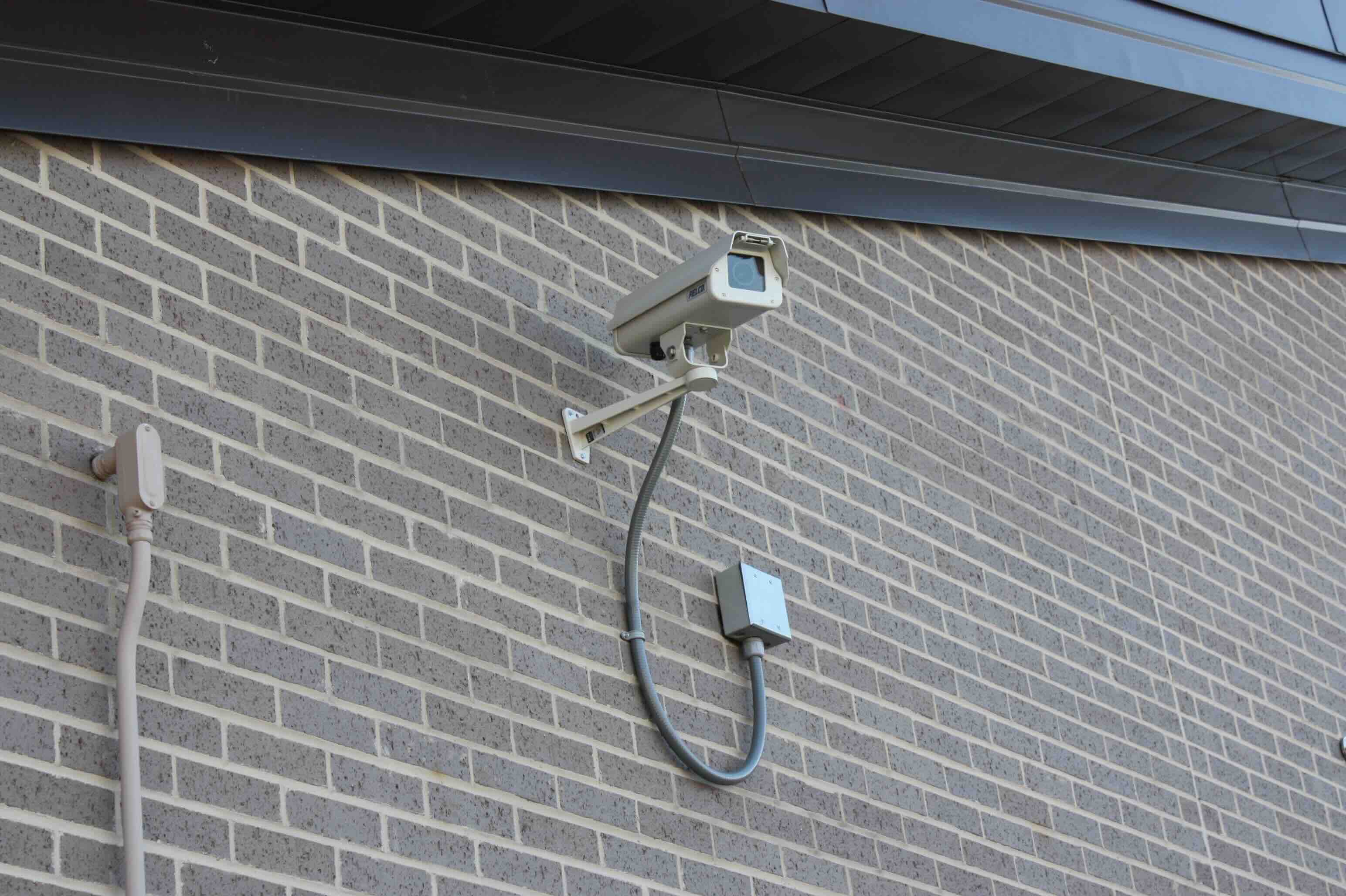Home>Home Security and Surveillance>What Are Intrusion Detection And Prevention Systems


Home Security and Surveillance
What Are Intrusion Detection And Prevention Systems
Modified: March 6, 2024
Looking to enhance your home security and surveillance? Learn more about intrusion detection and prevention systems and how they can protect your property.
(Many of the links in this article redirect to a specific reviewed product. Your purchase of these products through affiliate links helps to generate commission for Storables.com, at no extra cost. Learn more)
Introduction
When it comes to protecting our homes and loved ones, ensuring their safety is our top priority. In today’s world, where crime rates are increasing, having a reliable home security and surveillance system is essential. One such system that plays a crucial role in safeguarding our homes is an Intrusion Detection and Prevention System.
An Intrusion Detection and Prevention System (IDPS) is a powerful tool designed to detect and prevent unauthorized access or malicious activities within a network or system. These systems are specifically designed to monitor and analyze network traffic, identifying potential security breaches and taking immediate action to mitigate the risks.
With the increasing sophistication of cyber threats and the evolution of hacking techniques, it has become imperative to deploy robust security measures within our homes. Intrusion Detection and Prevention Systems provide an effective solution by actively monitoring network traffic, identifying patterns, and reacting intelligently to any suspicious activities.
In this article, we will delve into the key components of Intrusion Detection and Prevention Systems, their types, benefits, and the challenges associated with deploying such systems. We will also explore the best practices for implementing IDS and IPS to ensure the highest level of security for our homes.
So, whether you are a homeowner looking to enhance your home security or a security professional seeking a deeper understanding of IDPS, this article is here to guide you. Let’s dive in and explore the world of Intrusion Detection and Prevention Systems.
Key Takeaways:
- Intrusion Detection and Prevention Systems (IDPS) are like security guards for our homes and networks, working to detect and alert on potential threats while also actively blocking and preventing attacks in real-time.
- Implementing IDPS brings benefits like early threat detection, real-time monitoring, and automated responses, but it also requires careful management to address challenges like false alarms and evolving threats.
Definition of Intrusion Detection Systems
Intrusion Detection Systems (IDS) are a critical component of an Intrusion Detection and Prevention System (IDPS). They are designed to monitor network traffic, analyze it in real-time, and identify any suspicious or malicious activities.
IDS work by comparing the network traffic patterns against a predefined set of rules or signatures. These rules or signatures are created based on known attack patterns, vulnerabilities, and abnormal behavior to detect any signs of intrusion or unauthorized access.
There are two primary types of IDS: network-based and host-based IDS.
Network-based IDS (NIDS) are deployed at strategic points in the network infrastructure, such as routers or switches. They analyze network packets, looking for patterns that indicate an ongoing attack or suspicious behavior. NIDS can detect a wide range of attacks, including port scanning, Denial of Service (DoS) attacks, and malware outbreaks.
Host-based IDS (HIDS), on the other hand, are installed directly on individual hosts or servers. They monitor the activities happening on the host, such as file system changes, process monitoring, and log file analysis. HIDS are particularly useful for detecting attacks or unauthorized access that bypasses network-level security measures.
Both NIDS and HIDS generate alerts when they detect suspicious activities or potential intrusions. These alerts can be in the form of email notifications, SMS alerts, or centralized logging systems that security administrators can monitor and investigate.
It’s important to note that Intrusion Detection Systems are passive in nature, meaning they only detect and report on potential threats. They do not actively stop or prevent attacks. This is where Intrusion Prevention Systems (IPS) come into play, which we will discuss in the next section of this article.
In summary, Intrusion Detection Systems are an integral part of an IDPS, working tirelessly to monitor network traffic and identify any signs of intrusion or unauthorized access. By detecting and alerting security administrators of potential threats, IDS provide valuable insights that enable proactive mitigation measures to be taken.
Overview of Intrusion Prevention Systems
Building upon the foundation laid by Intrusion Detection Systems (IDS), Intrusion Prevention Systems (IPS) take security to the next level by actively preventing and blocking potential threats in real-time.
IPS works by analyzing network traffic, similar to IDS, but with the added capability of taking immediate action to stop or mitigate threats. These systems use a combination of rule-based detection, anomaly detection, and behavior analysis to identify and respond to malicious activities.
When an IPS detects a potential intrusion or attack, it can take various actions to prevent further harm. These actions can include blocking the IP address or source of the attack, terminating the network connection, or modifying firewall rules to deny access.
IPS can be deployed in-line, meaning that the network traffic passes through the IPS, allowing for real-time monitoring and blocking of threats. Alternatively, IPS can be deployed out-of-band, where a copy of network traffic is sent to the IPS for analysis. Out-of-band deployment does not interfere with network traffic flow but introduces a slight delay in detecting and blocking threats.
One of the key advantages of IPS is its ability to defend against zero-day attacks. Zero-day attacks are previously unknown vulnerabilities or exploits that attackers may use before security patches or signatures are available. IPS can detect and take action against such attacks based on abnormal behavior or heuristics.
IPS can also provide additional security features, such as web application firewalls (WAF) and malware detection. Web application firewalls protect web applications from common attacks, such as SQL injection or cross-site scripting, by analyzing HTTP traffic and blocking potential malicious requests. Malware detection capabilities enable IPS to scan network traffic for known malicious files or malware signatures and block their transmission or execution.
Just like IDS, IPS generates alerts when it detects and blocks potential threats. These alerts allow security administrators to investigate the incident and implement additional security measures if needed.
Overall, Intrusion Prevention Systems are a crucial defense mechanism in protecting our homes and networks from potential attacks. By actively detecting and blocking threats in real-time, IPS provides an added layer of security that complements the capabilities of Intrusion Detection Systems.
Key Differences Between IDS and IPS
Intrusion Detection Systems (IDS) and Intrusion Prevention Systems (IPS) are both vital components of an Intrusion Detection and Prevention System (IDPS). While they share similarities in terms of monitoring network traffic and detecting potentially malicious activities, there are key differences between the two.
1. Function: The primary function of an IDS is to detect and alert on potential security threats or intrusions. It passively monitors network traffic, analyzes it, and generates alerts that security administrators can investigate. On the other hand, IPS not only detects potential threats but also takes active measures to block or prevent them in real-time.
2. Response: IDS responds to detected threats by generating alerts for further analysis and action by security administrators. In contrast, IPS actively responds to threats by employing various mitigation techniques, including blocking IP addresses, terminating network connections, or modifying firewall rules to prevent further intrusions.
3. Action: IDS is primarily focused on providing information and intelligence about potential threats. It does not take any direct action to stop or prevent attacks. Conversely, IPS is designed to actively intervene and prevent attacks by taking immediate action when suspicious activities are detected.
4. Real-time vs. Post-event Analysis: IDS offers real-time monitoring and alerts, allowing security administrators to investigate and respond to potential threats as they occur. Conversely, IPS provides real-time analysis and response, actively blocking threats as they are detected, helping to prevent damage or compromise before it occurs.
5. Flexibility: IDS allows for flexibility in terms of analysis and response to potential threats. Security administrators can define and modify the rules or signatures used by IDS, tailoring the system to the specific needs and risks of their environment. On the other hand, IPS has more limited flexibility since it is designed to take automated and immediate actions to block or prevent threats based on predefined rules.
6. False Positives: IDS might generate false positives, meaning it may raise alerts for legitimate activities mistaken as potential threats. While this can be time-consuming to investigate, it provides a thorough analysis of network traffic. On the other hand, IPS is more prone to false negatives, where it may fail to detect sophisticated or novel threats due to the limitations of predefined rules or signatures.
In summary, while both IDS and IPS play crucial roles in network security, their main differences lie in their functionality, response capabilities, and level of active protection. IDS provides valuable insights and alerts to security administrators, while IPS takes proactive measures to actively prevent and block potential threats in real-time.
Components of Intrusion Detection and Prevention Systems
Intrusion Detection and Prevention Systems (IDPS) are composed of several key components, working together to provide comprehensive security for our homes and networks. Understanding these components is essential for effectively deploying and managing an IDPS.
1. Sensors: Sensors are the frontline components of an IDPS. They are responsible for collecting and analyzing network traffic data. In a network-based IDPS, sensors are strategically placed throughout the network infrastructure, such as routers or switches, to capture and monitor traffic. In a host-based IDPS, sensors are installed directly on individual hosts or servers to monitor local system activities.
2. Analyzers: Analyzers, also known as the detection engine, are responsible for analyzing the data collected by the sensors. They compare the network traffic patterns against predefined rules, signatures, or behavioral models to identify potential threats or abnormal activities. Analyzers employ various techniques, such as pattern matching, anomaly detection, and heuristics, to detect different types of attacks or intrusions.
3. Central Console: The central console serves as the management interface for the IDPS. It provides a centralized view of the system, allowing security administrators to configure and manage the sensors, analyzers, and other components of the IDPS. The console also receives and displays alerts generated by the system, providing a comprehensive overview of security incidents.
4. Database: The database component of an IDPS stores various information related to security events, alerts, and system configuration. It serves as a repository for storing logs, capturing and archiving network traffic data, and maintaining a historical record of security incidents. The database is essential for post-incident analysis, forensic investigation, and compliance reporting.
5. Response Mechanism: The response mechanism is a critical component of an IDPS, particularly in Intrusion Prevention Systems (IPS). It defines how the system responds when a potential threat or intrusion is detected. The response mechanism can include blocking the malicious IP address, terminating the network connection, modifying firewall rules, or triggering automated mitigation actions to prevent further damage.
6. Reporting and Alerting: Reporting and alerting components provide timely notifications and reports to security administrators. They generate alerts when potential threats are detected, allowing administrators to take immediate action. Additionally, reporting functionalities provide insights into system performance, security incidents, and compliance adherence, enabling administrators to assess the effectiveness of the IDPS and make necessary improvements.
7. Integration: IDPS components should be capable of integrating with other security solutions and systems within the network environment. Integration with firewalls, Security Information and Event Management (SIEM) systems, and other security tools enhances the overall security posture, allowing for better correlation and analysis of security incidents across the network.
By understanding the key components of an Intrusion Detection and Prevention System, we can better appreciate how each component plays a crucial role in safeguarding our homes and networks against potential threats. A well-integrated and properly configured IDPS ensures a robust and proactive defense against unauthorized access and malicious activities.
Tip: Intrusion detection and prevention systems are security tools that monitor network traffic for suspicious activity and can automatically block or alert administrators to potential threats. Regularly update and configure these systems to effectively protect your network.
Types of Intrusion Detection and Prevention Systems
Intrusion Detection and Prevention Systems (IDPS) come in various types, each catering to specific security requirements and network environments. Understanding these different types can help determine the most suitable IDPS for our homes and networks. Let’s explore some of the common types of IDPS:
1. Network-based Intrusion Detection and Prevention Systems (NIDPS): NIDPS, as the name suggests, focus on monitoring and analyzing network traffic to detect and prevent potential threats. They are typically deployed at strategic points in the network infrastructure, such as routers and switches. NIDPS examine network packets, looking for patterns that match known attack signatures or abnormal behavior. These systems can effectively detect various types of attacks, including port scanning, Denial of Service (DoS) attacks, and malware outbreaks.
2. Host-based Intrusion Detection and Prevention Systems (HIDPS): HIDPS operate at the individual host or server level. They monitor and analyze activities happening on the host, such as file system changes, process monitoring, and log file analysis. HIDPS can detect attacks or unauthorized access that bypass network-level security measures. They are especially useful in environments where network traffic may be encrypted or where there is a need for granular visibility into host-level activities.
3. Hybrid Intrusion Detection and Prevention Systems: Hybrid IDPS combine the capabilities of both NIDPS and HIDPS. These systems offer a comprehensive approach to network security by monitoring both network-level traffic and host-level activities. Hybrid IDPS provide a more holistic view of the network environment and can detect threats that might be missed by using only one type of IDPS.
4. Signature-based Intrusion Detection and Prevention Systems: Signature-based IDPS rely on predefined rules or signatures to identify known attack patterns or malicious activity. These signatures are developed based on previous knowledge of attacks or vulnerabilities. Signature-based IDPS compare network traffic against these signatures and generate alerts or take action when a match is found. While effective against known threats, signature-based IDPS may have limitations in detecting new or unknown attacks.
5. Anomaly-based Intrusion Detection and Prevention Systems: Anomaly-based IDPS focus on detecting deviations from normal network behavior. They establish a baseline of normal activity and analyze network traffic for any anomalies or deviations. Anomaly-based IDPS can detect unknown attacks by identifying patterns or behaviors that deviate significantly from the established baseline. However, these systems may be more prone to false positives due to normal variations in network traffic.
6. Behavior-based Intrusion Detection and Prevention Systems: Behavior-based IDPS monitor network traffic and host activities for suspicious behavior or activities that indicate potential threats. These systems use machine learning or advanced behavioral analysis techniques to identify patterns or anomalies that are indicative of attacks. Behavior-based IDPS can detect zero-day attacks and advanced persistent threats by detecting abnormal behavior that may not match known signatures or patterns.
By considering the types of Intrusion Detection and Prevention Systems available, we can choose the most appropriate solution for our specific security needs. Implementing the right IDPS can significantly enhance our ability to detect, prevent, and respond to potential security threats, ultimately ensuring the safety and integrity of our homes and networks.
Benefits of Implementing IDS and IPS
Implementing Intrusion Detection and Prevention Systems (IDPS) provides numerous benefits in terms of enhancing the security and resilience of our homes and networks. Let’s explore some of the key advantages of deploying an IDPS:
1. Threat Detection: The primary benefit of IDPS is its ability to detect potential threats and security breaches. By monitoring network traffic and analyzing patterns or behaviors, IDPS can identify malicious activities, unauthorized access attempts, or unusual behavior that may indicate a security risk. This early detection allows security administrators to respond promptly and mitigate potential damage.
2. Real-time Monitoring: IDPS provides real-time monitoring of network traffic, ensuring immediate visibility and awareness of potential security incidents. This proactive monitoring allows for quick identification and response to threats, minimizing the impact of attacks and reducing the time for malicious activity to go undetected.
3. Automated Response: In the case of Intrusion Prevention Systems (IPS), IDPS can automatically respond to detected threats and attacks, thus preventing further damage or compromise. Automated responses can include blocking suspicious IP addresses, terminating connections, or modifying firewall rules to deny access. This automated response capability enables a swift and efficient reaction to mitigate the risk.
4. Enhanced Security Posture: By implementing IDPS, the overall security posture of the network is greatly strengthened. IDPS offers an additional layer of defense, working alongside firewalls and other security measures, to provide comprehensive protection against potential threats. This multi-layered approach significantly reduces the chances of successful attacks.
5. Compliance and Regulatory Requirements: Many industries and organizations have specific compliance and regulatory requirements related to security. Implementing IDPS can help meet these requirements by ensuring continuous monitoring, incident response mechanisms, and the ability to generate detailed reports. Compliance with these regulations not only safeguards the organization but also builds customer trust and confidence.
6. Forensic Analysis: IDPS generates detailed logs and alerts that can be used for forensic analysis in the event of a security incident. These logs provide an audit trail of network activity, aiding in the identification of the attack vector, the scope of the compromise, and the actions taken by the attacker. Having a comprehensive record of these events is invaluable for conducting thorough investigations and implementing preventive measures for the future.
7. Scalability and Flexibility: IDPS can be scaled and tailored to the specific needs of the network environment. They can be deployed in small homes or large enterprise networks, accommodating various traffic volumes and requirements. IDPS also allows for customization, enabling security administrators to define and modify rules, signatures, or policies to adapt to evolving threats and security landscape.
Implementing IDS and IPS brings significant benefits to the security and resilience of our homes and networks. These systems provide proactive threat detection, real-time monitoring, automated response capabilities, enhanced security posture, and compliance adherence. By leveraging the advantages of IDPS, we can effectively protect our assets, data, and loved ones from potential security breaches and cyber threats.
Challenges and Limitations
While Intrusion Detection and Prevention Systems (IDPS) offer numerous benefits in terms of enhancing security, they also face certain challenges and limitations. Understanding these challenges is crucial for effectively managing and mitigating potential limitations. Let’s explore some of the common challenges and limitations of IDPS:
1. False Positives: IDPS may generate false positives, raising alerts for legitimate activities mistaken as potential threats. These false alarms can create noise and add unnecessary overhead for security administrators who need to investigate and validate each alert. Reducing false positives requires fine-tuning the rules, signatures, and thresholds of the IDPS to strike the right balance between detection accuracy and false alarms.
2. False Negatives: Conversely, IDPS may also experience false negatives, where they fail to detect sophisticated or novel threats. This limitation arises from the use of predefined rules or signatures that might not encompass all possible attack vectors. To mitigate this limitation, using behavior-based analysis and incorporating threat intelligence can help identify emerging threats and reduce the likelihood of false negatives.
3. Performance Impact: IDPS can have a performance impact on network devices and systems due to the additional processing and analysis they require. This impact can result in increased latency, decreased network throughput, or system resources being diverted to IDPS tasks. Careful monitoring and optimization of IDPS deployments can help mitigate performance issues and ensure minimal impact on network performance.
4. Complexity and Management: IDPS requires skilled personnel knowledgeable in security practices and the management of these systems. Configuring and managing IDPS can be complex, requiring ongoing monitoring, rule updates, and response tuning. Adequate training and resources are necessary to ensure effective management and optimization of IDPS deployments.
5. Evolving Threat Landscape: The rapidly evolving nature of cyber threats presents a significant challenge for IDPS. Attackers continuously develop new techniques and exploit vulnerabilities, making it essential for IDPS to stay up-to-date with the latest threat intelligence and attack vectors. Regular updates and integration with threat intelligence platforms are crucial to keep IDPS effective and responsive to emerging threats.
6. Encryption and Encrypted Traffic: Encrypted traffic poses a challenge for IDPS, as it limits the visibility and analysis capabilities of the system. Attackers can leverage encryption to disguise their activities and bypass traditional IDPS detection mechanisms. Techniques such as SSL/TLS inspection can be employed to decrypt and inspect encrypted traffic, but it requires careful implementation and necessary compliance considerations.
7. Cost and Resource Allocation: Implementing and maintaining IDPS can involve significant costs, including hardware, software, licensing, and ongoing operational expenses. Additionally, IDPS requires dedicated resources for monitoring, managing, and responding to alerts and incidents. Organizations must carefully evaluate the cost-effectiveness and allocate resources accordingly to ensure a properly functioning IDPS implementation.
Despite these challenges and limitations, IDPS remains a vital component in defending against potential security breaches and cyber threats. By addressing these limitations through regular monitoring, updates, optimization, and resource allocation, organizations can maximize the effectiveness and benefits offered by IDPS.
Best Practices for Deploying IDS and IPS
Deploying Intrusion Detection and Prevention Systems (IDPS) requires careful planning, implementation, and management to ensure their effectiveness. Adhering to best practices can help maximize the value of IDPS and enhance the security of our homes and networks. Let’s explore some key best practices for deploying IDS and IPS:
1. Conduct a Risk Assessment: Before deploying IDPS, conduct a thorough risk assessment to identify potential security threats and vulnerabilities in the network. This assessment helps determine the areas that require heightened monitoring and protection, allowing for a more targeted and effective deployment of IDPS.
2. Define Clear Objectives and Policies: Clearly define the objectives and goals of deploying IDPS. Establish policies and guidelines for alert management, incident response, and system administration. Having well-defined objectives and policies helps align the use of IDPS with organizational goals and improves overall security operations.
3. Choose the Right IDPS Solution: Select an IDPS solution that best fits your specific requirements, taking into consideration factors such as the size of the network, traffic volume, and security needs. Evaluate different solutions, consider their features, scalability, ease of management, and integration capabilities to ensure a seamless deployment.
4. Design a Well-Planned Architecture: Create a well-designed IDPS architecture that takes into account network topology, traffic flow, and critical assets. Consider the placement of sensors or agents to ensure adequate coverage and visibility throughout the network. Strive for a balance between detection accuracy, system performance, and resource utilization.
5. Regularly Update Signatures and Rules: Keep your IDPS up-to-date with the latest threat intelligence by regularly updating the signatures, rules, and behavior models. This ensures that the IDPS can detect and respond to emerging threats effectively. Implement a process for timely updates and patch management to stay protected against new vulnerabilities.
6. Monitor and Analyze Alerts: Establish a systematic approach to monitor and analyze the alerts generated by IDPS. Implement a centralized logging and reporting mechanism to ensure that alerts are properly captured and investigated. Apply prioritization to focus on critical alerts and have a designated team responsible for reviewing and responding to alerts promptly.
7. Regularly Review and Fine-Tune: Perform regular reviews and assessments of the IDPS deployment to fine-tune the detection capabilities. Analyze false positives and false negatives to adjust the thresholds, rules, or signatures as needed. Continuous monitoring and optimization help optimize the effectiveness of IDPS and reduce unnecessary overhead.
8. Perform Incident Response Exercises: Regularly conduct incident response exercises to test the effectiveness of the IDPS and the incident response plan. Simulate different attack scenarios to assess the ability of IDPS to detect and respond to various threats. Incorporating lessons learned from these exercises helps improve the overall security posture and response readiness.
9. Train Personnel: Provide training and education to security personnel responsible for managing the IDPS. Ensure they are familiar with the system’s capabilities, monitoring techniques, and incident response procedures. Ongoing training helps enhance their skills in identifying potential threats, fine-tuning the system, and responding effectively.
10. Regularly Review IDPS Performance: Continuously evaluate and review the performance of the IDPS to ensure it meets the evolving security needs. Monitor key performance indicators, such as detection rate, incident response time, and false positive/negative ratios. Regular performance reviews help identify areas for improvement and support informed decision-making for future enhancements.
By following these best practices, organizations can establish a robust and effective deployment of Intrusion Detection and Prevention Systems. Proper planning, configuration, ongoing management, and training all contribute to maximizing the value of IDPS and maintaining a strong security posture.
Conclusion
In today’s increasingly digital and connected world, the importance of home security and network protection cannot be overstated. Intrusion Detection and Prevention Systems (IDPS) play a crucial role in safeguarding our homes and networks from potential threats and unauthorized access.
In this article, we explored the definition of IDPS and gained an understanding of the components, types, and benefits associated with implementing these systems. We learned that Intrusion Detection Systems (IDS) are designed to detect and alert on potential security threats, while Intrusion Prevention Systems (IPS) provide active measures to block and prevent attacks in real-time.
By employing IDPS, we enhance our security posture through threat detection, real-time monitoring, automated responses, and improved compliance adherence. These systems enable early detection and rapid response to potential intrusions, minimizing the impact of attacks and protecting our homes and networks.
However, we also acknowledged the challenges and limitations of IDPS, including false positives, false negatives, performance impact, and the ever-evolving threat landscape. It is important to address these challenges by carefully fine-tuning and optimizing the IDPS deployment, in addition to regularly updating rules, monitoring alerts, and conducting ongoing training for security personnel.
By following best practices for deploying IDPS, such as conducting a risk assessment, choosing the right solution, and designing a well-planned architecture, we can maximize the effectiveness of these systems. Regular reviews, incident response exercises, and proper training further strengthen our defense against potential security breaches.
In conclusion, implementing Intrusion Detection and Prevention Systems is a critical step in ensuring the safety, integrity, and privacy of our homes and networks. With the ever-increasing sophistication of cyber threats, deploying IDPS provides an essential layer of protection and peace of mind. By staying proactive, adhering to best practices, and continuously improving our security measures, we can mitigate risks, respond to incidents effectively, and maintain a robust defense against potential intrusions.
Frequently Asked Questions about What Are Intrusion Detection And Prevention Systems
Was this page helpful?
At Storables.com, we guarantee accurate and reliable information. Our content, validated by Expert Board Contributors, is crafted following stringent Editorial Policies. We're committed to providing you with well-researched, expert-backed insights for all your informational needs.













